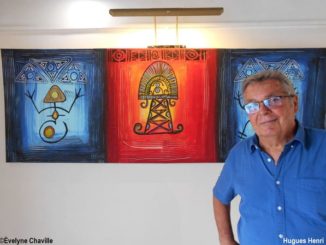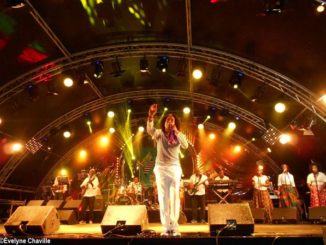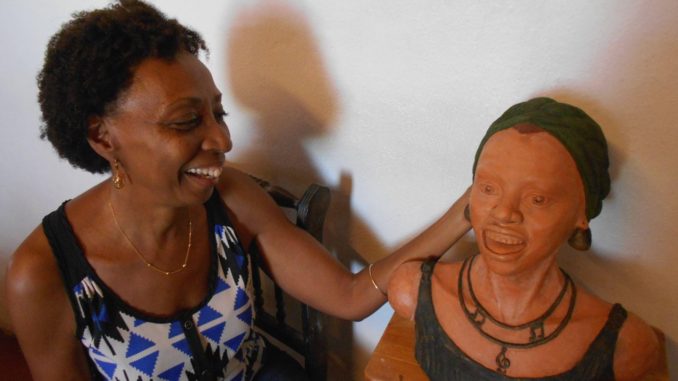
Having had a first contact with clay in 1978, Nicole Favières-Bourguignon never has stopped discovering the sculpting techniques. Her thirst for knowledge in the field of the plastic arts has driven her to study with great names of sculpting, drawing and painting. If this social worker by profession has participated in collective exhibitions, she has not yet decided to show alone all the works she is capable of producing.
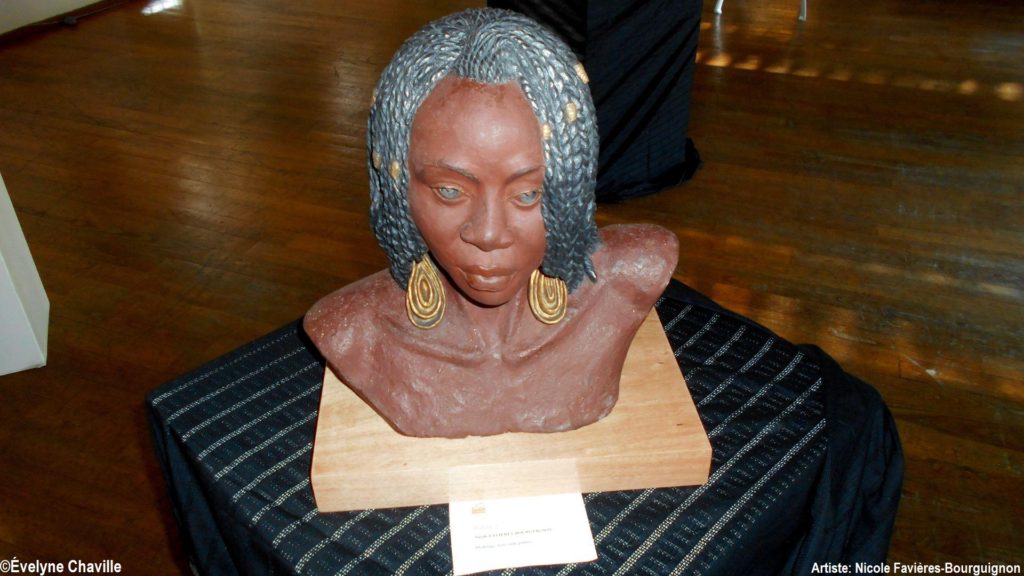
When, for the first time, you enter Nicole Favières-Bourguignon’s house located in the town of Petit-Bourg, you will never imagine that it contains a large number of carvings of great beauty. All the works are in the living room and in the kitchen but without any ostentation because the artist is distinguished by her talent but also by her discretion. At the moment when many call themselves “artists” by showing derisory proof of their creativity, Nicole Favières-Bourguignon who is a real art creator claims no title, she just allows herself be led by her passion in which she first wants to flourish. It must be said that just before this article for our magazine, this social worker who works in the field of child adoption had never really wondered about what had led her to art, to sculpture. Upon reflection, she found that it was her family because each member has a personal creative area, in particular her mother.
“With hindsight, I realized that my mother who was a nurse had always created, she painted tablecloths of the church and she always taught me to look at the carvings. Devout Catholic, she shared with me her admiration for all these statues exhibited in particular in the Church of Saint-Pierre and Saint-Paul in Pointe-à-Pitre but also in other churches of Guadeloupe, France and elsewhere. She told me to admire the expressions on the saints’ faces, the drape and transparency effects of the veils carved in marble etc. She often mentioned how, as a child, she modeled figurines in the mud”, tells Nicole Favières-Bourguigon. However, if she always listened to her mother’s comments and watched her works, the girl she was, at that time, never was attracted by this artistic discipline.
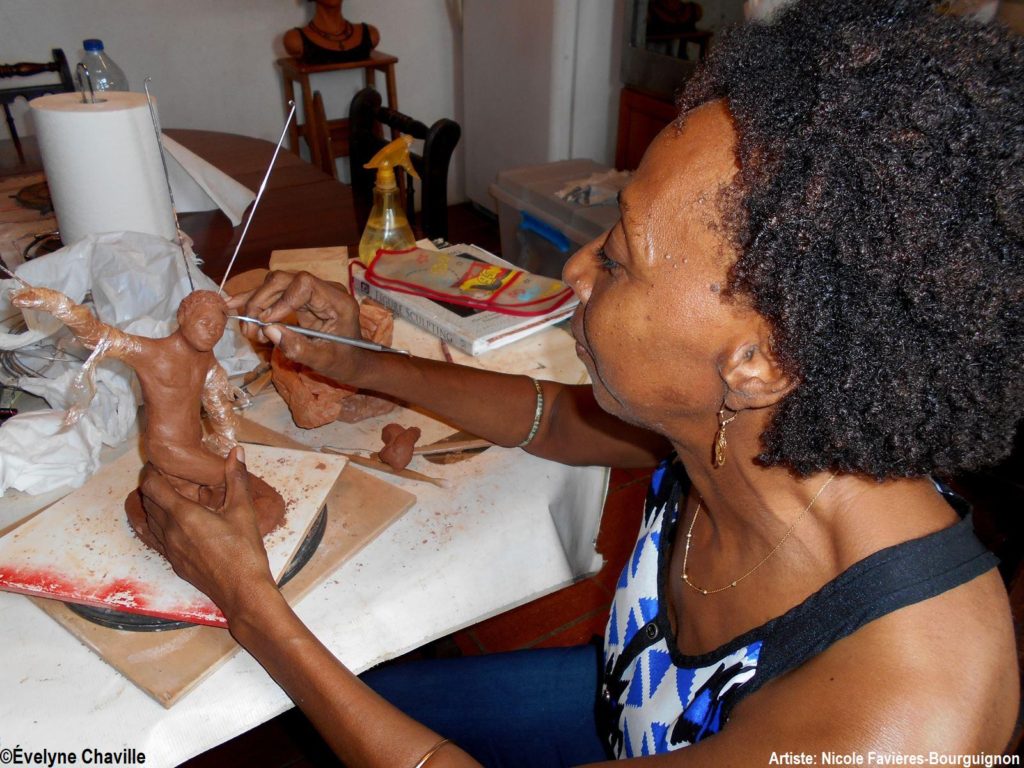
The discovery of clay
In 1978, Nicole Favières-Bourguignon had her first contact with what she names, with great respect, “Soil”. It happened during an internship in the Yvelines (France) in an institution called “La Rencontre” (The Meeting) – a predestined name – when she was a student. It was an experience unbelievable for her : “I participated in a pottery workshop. I loved this plastic and malleable material which can solidify at the same time and, in addition, receive textures and colors ! What a pleasure!”, she says. In 1990, after the birth of her children, Nicole Favières-Bourguignon wanted to create with her hands. So, her sister told her about a pottery course organized by Sylvie Tersen (museum curator) with Mireille Prompt (sculptor) at the Musée Saint-John Perse in Pointe-à-Pitre. “At that time,”pottery” meant “jar” to me. So, I learned how to make jars. I discovered and I was initiated to the art of Native American pottery (…) But especially, during a visit to Mireille, I discovered the boundless world of the shape and the infinity of this shape, the endless possibilities with clay”, she says. The young woman continued her training with the sculptor Patrick Proust who taught her, among other things, the wheel, the body modelling and the theory of firing. “Then, I realized how much clay was exactly what I needed and made me feel in my rightful place”, she says. After these different courses, Nicole bought some clay to try to create her own works from the different techniques she learned. She still has at home some utilitarian objects she made when she started (soap dishes, fruit basket, wall lamps etc.).
Some time later, she attended the potter Gilles Kali’s course, at the Centre des Métiers d’Art. At home, she tried to produce a piece from what she saw or imagined. Passionate about African art, she used this one for her creations such as masks or statuettes. She also tried to reproduce the human body, in particular the face.
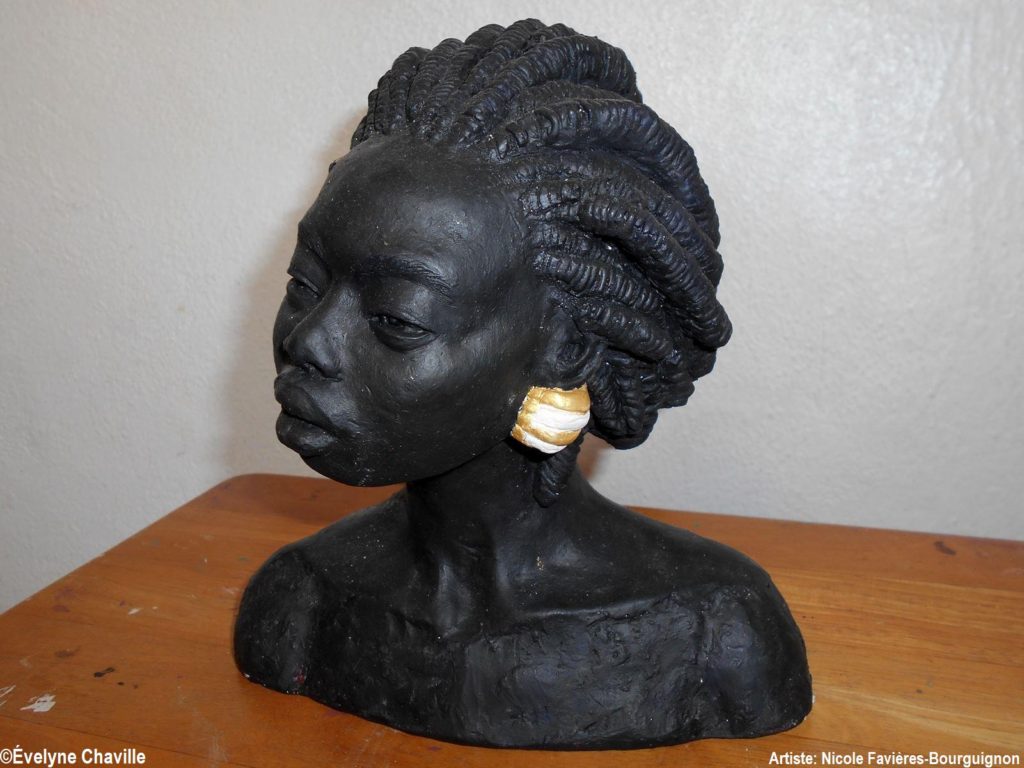
A great thirst for knowledge
In her quest for techniques, she bought books, she did research. She discovered the work by some authors such as Bérit Hildre, the Norwegian sculptor and Monique Sidelsky, the French sculptor. She was fascinated by works made by Guadeloupean sculptor Jacky Poulier. From 1997 to 1999, Nicole Favières-Bourguignon took a volume course as an auditor at the Centre d’Arts Plastiques in Le Lamentin run by Michel Rovélas. She had already met the one who is considered one of the pioneers regarding plastic arts in Guadeloupe because, a few years earlier, he had opened his “Galerie Igha-Igha” in the district of Pointe-à-Pitre where she lived. During this second meeting, she learned the plaster sculpture, wood carving etc. According to her availability, she attended lectures on art in the Caribbean and she enjoyed the interventions of Cuban professor, researcher and art critic, Yolanda Wood, or those of Guadeloupean philosophy teacher Cyril Serva. “I enjoyed listening to these people who talked about the history of art in the Caribbean. Previously, I was indifferent to Haitian art but when they began to explain it, it made sense (…) The works of students exhibited at the end of the year will be my first exhibitions that will confront me with the profound sense of anxiety that can provide this experience”, she says. After this training, the sculptress decided to give free rein to her imagination and she embarked on the decoration of her kitchen by making bas-reliefs for the doors of the cabinets.
From 2002 to 2004, she became one of Maurice Vital’s students at the Office Municipal de la Culture et du Sport (OMCS) in Le Gosier to learn drawing. “Maurice will be one of these people who will urge me to dare to expose myself”, she says.The Haitian plastic artist often told her : “Nicole, you must stop hiding your works under your bed!”, so that she understands that her work deserved to be seen… She did not escape the end-of-year exhibitions which took place in the media library of the commune. Then, she went to improve her apprenticeship in drawing and to take an introductory course in oil painting with the painter Catherine Pugliesi-Conti.
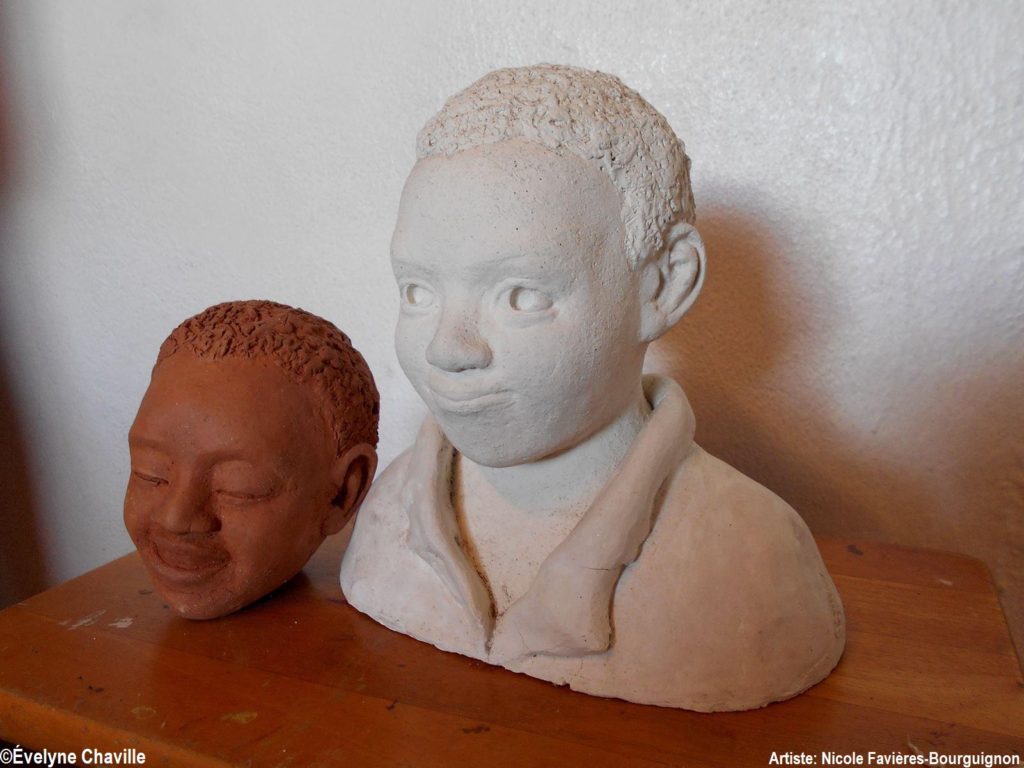
An internship with Philippe Faraut in the United States
In 2009 and 2011, she joined the Alizarine association where she took part in two group exhibitions entitled “Visions d’Auteurs, Lectures de Peintres”. Concretly, it was a question of creating works from a passage of a Caribbean novel. Nicole will take inspiration from Creole poems and especially from the famous novel “Pluie et Vent sur Télumée Miracle” by Simone Schwarz-Bart which marked her adolescence to give life to several characters. In 2009, she sold her first sculpture, the character of Victoire, the buyer fell in love with this work at first sight… During a trip to Paris, Nicole Favières-Bourguignon who is always in search of knowledge, contacted sculptor Élisabeth Bonvalot’s workshop to learn, among others, patinas.
Also in 2011, Editions Nestor published the collection of speeches of the colloquium “Imaginaire créole et rézonans” organized by the association of psychologists of Guadeloupe; pieces from her previous exhibition were selected to illustrate this publication. That same year, her companion, Eugène Louisor, added the plastic arts to the Festival International du Zouk (FIZ) he organizes and he asked her to set up the collective exhibition which takes place every year in August in the Centre Culturel Rémi Nainsouta and has become a showcase for the plastic arts in Guadeloupe. For the 2017 edition, the artist dared to sculpt the face of the late zouk singer, Patrick Saint-Éloi… In 2012, Nicole Favières-Bourguignon began the production of “Antillane”, a sculpture representing the West Indian version of “Marianne”, the French national symbol. However, her insatiable search for artistic knowledge is too great so, encouraged by her children, she made a dream a reality : to participate in the sculpture seminar – attended by artists of all nationalities – organized by the famous Philippe Faraut at his home in Honeoye, New York State. She was accompanied by her daughter and her son during this long journey to the United States… Today, the artist plans to go back there to discover other techniques with the master.
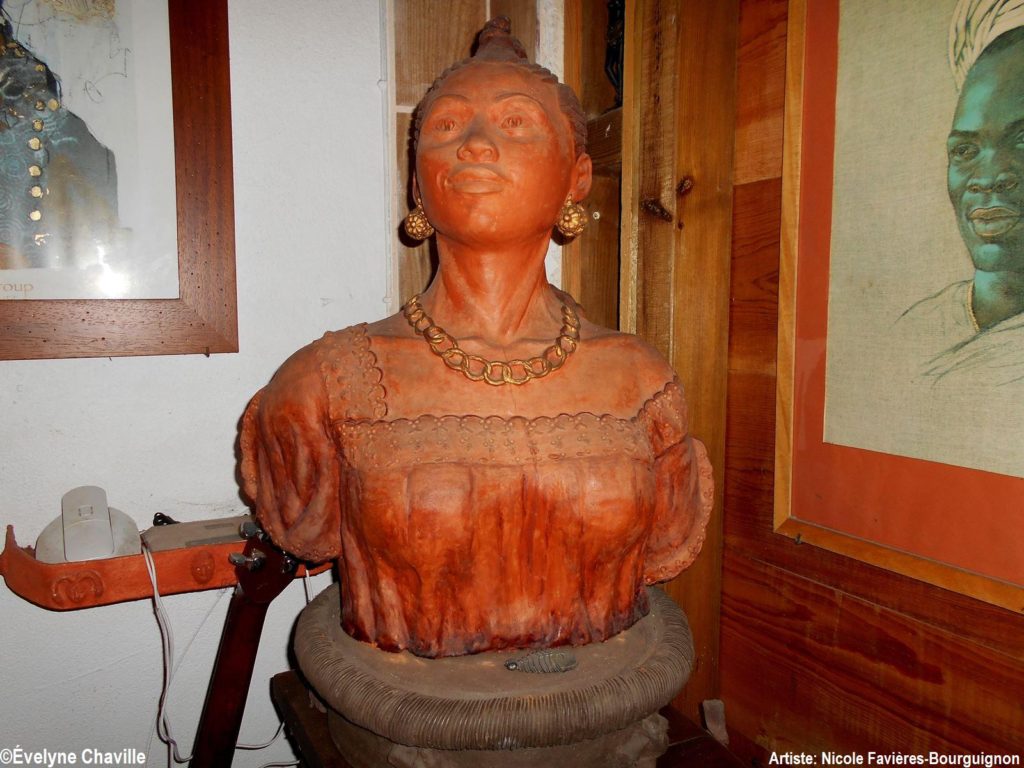
The Antillane, a real challenge
On her return, she continued the creation of “Antillane”, this imposing bust in red clay of a woman in a traditional dress, with Creole jewels, braids and “choux” which is a summary of the various contributions in our culture. “Through my work, I am spontaneously in search of the “we”, our representation, our postures of yesterday and today, our ways of being and doing”, says the artist. Following this challenge, Nicole participated in other collective exhibitions such as “Terra Sylva”, organized by Karukéra Bonzaï in 2014, “Ça crée fort”, set up by the residents of Fort Fleur d’Epée in 2015 and then, she helped the association Libell’Art for the production of clay jewelry. That same year, as Nicole is never very far from an internship, she attended a ceramic training on the island of Désirade and, in 2016, she learned the raku firing process with the ceramist, Laéticia Édouard. In the same period, with Jean-Louis Halley (painter), Véronique Rolnin (painter and sculptor) and members of Libell’Art, she took part in the design of a background of the stage for a dance show called “De l’Égypte à la Guadeloupe”. A great opportunity for her to discover large-format painting…
After almost thirty years of sculpting, Nicole Favières-Bourguignon knows that, one day, she will be confronted with herself by producing her first personal exhibition. She currently considers this art as a moment of pleasure.
















































